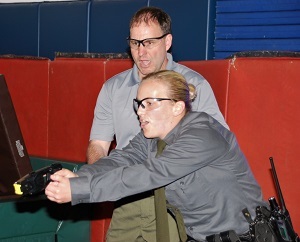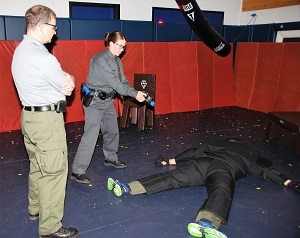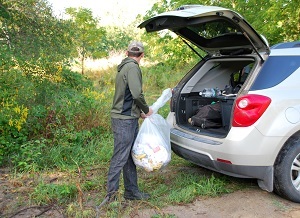Recruits find training ‘stunning’ as they learn Taser tactics
Week 8: Sept. 3-9, 2017
The best way to describe Week 8 in the Department of Natural Resources Conservation Officer Recruit School? Try “electrifying.” Or “shocking.” Even “stunning.”
 Bad puns aside, recruits were introduced to a key piece of law enforcement equipment carried by all conservation officers: Tasers, or “stun guns.” This conductive energy device (CED) allows officers to subdue a combative or resisting suspect without lethal force or a physical confrontation. The training was part of a continuing emphasis on self-defense tactics and legal instruction that marked Week 8. Bad puns aside, recruits were introduced to a key piece of law enforcement equipment carried by all conservation officers: Tasers, or “stun guns.” This conductive energy device (CED) allows officers to subdue a combative or resisting suspect without lethal force or a physical confrontation. The training was part of a continuing emphasis on self-defense tactics and legal instruction that marked Week 8.
Partial week, full effort
When recruits returned from their long Labor Day weekend, they quickly realized that their four-day work week still demanded a full week’s worth of effort.
They got back into the swing of things Tuesday with classroom instruction on weapons and contraband laws from retired Michigan State Police inspector David Greydanus. As certified peace officers, Michigan conservation officers are expected to be well-versed in all criminal laws. Recruits will learn in the field that conservation-based violations and  general criminal violations often go hand in hand. general criminal violations often go hand in hand.
Recruits were issued Tasers Wednesday. They spent most of the week learning the laws, factors and deployment strategies when using the devices. “Proper training and use of CEDs have reduced the risk of harm to police officers and suspects,” Cpl. Steve Martin said. “There is no question that the use of CEDs has saved many lives.”
Keeping it real
There’s no substitute for hands-on training, as recruits found Thursday when they took their Tasers from the classroom into a variety of controlled scenarios. Trainees began by discharging their Tasers at plywood targets to practice shot placement. But the real pressure began to build with each subsequent scenario.
Instructors took things up a notch by creating a series of stressful situations for recruits, including a simulated bar room scene with a conservation officer posing as a rowdy  patron. Recruits were called into a dimly light room where music was blaring. Once inside, trainees were confronted with a chaotic scene by role-playing instructors yelling commands, and an officer wearing protective gear who posed as the unruly patron. Recruits had to sort through the commotion and take control of the situation, deploying their Tasers on the “patron.” patron. Recruits were called into a dimly light room where music was blaring. Once inside, trainees were confronted with a chaotic scene by role-playing instructors yelling commands, and an officer wearing protective gear who posed as the unruly patron. Recruits had to sort through the commotion and take control of the situation, deploying their Tasers on the “patron.”
Thursday evening ended with the third legal exam covering weapons and contraband.
Putting it into practice
On Friday, recruits ran through an off-site scenario that let them put their legal training to use. In this exercise, recruits responded to a complaint of littering on state-managed land. Once on the scene, they found a conservation officer posing as a suspect who was dumping trash. Upon making contact, recruits discovered paraphernalia and other signs of marijuana use. This scenario was the first in which recruits had to deal with multiple violations and decide what enforcement action was needed. Since conservation officers often come across people in the process of violating a law, they must learn to act quickly and be decisive in their actions. come across people in the process of violating a law, they must learn to act quickly and be decisive in their actions.
Friday afternoon saw the class focus on administrative tasks, report writing and test reviews.
Out of their comfort zone
Even though recruits conquered another week of training, they shouldn’t get complacent. Week 9 will be looming large when they return Sunday night. Week 9 training will shake things up by taking the class out of its comfort zone. Recruits will leave the academy’s confines and spend the week at the Camp Grayling Joint Maneuver Training Center for weapons training. It’s a big step in their development. It’s also one of the biggest hurdles, and each recruit had better bring his or her “A” game.
Subscribe to the weekly conservation officer academy blog, which also will be posted on the Michigan DNR Facebook page. View previous blogs from Recruit School #8.
/Note to editors: Accompanying photos are available below for download. Caption information follows.
Taser_training: A recruit locks on to a plywood target and lets loose with his Taser during training. Tasers, or electronic “stun guns,” are valuable law enforcement tools as they let conservation officers subdue a combative or resisting subject without lethal force or a physical confrontation.
Handling_stress: Cpl. Steve Martin keeps the pressure on a recruit practicing with her Taser. To help the class adapt to real-world situations, Cpl. Martin and his instructors put recruits in scenarios involving loud noises and low lighting, which teaches them to tune out distractions and take control of the situation.
Taking_aim: Cpl. Steve Martin gauges a recruit’s aim and technique with a Taser during training.
Keeping_it_real: Cpl. Steve Martin assesses a recruit’s performance during a realistic Taser training session that tests the class’s ability to handle stressful situations. Instructors, including one wearing gear designed to protect against Taser hits, pretended to be part of a rowdy bar room disturbance. The scene was complete with blaring music and dim lighting, all designed to teach recruits to stay calm and professional when handling tense situations.
Dumping_trash: A conservation officer pretends to dump trash illegally as part of an exercise that teaches recruits how to respond to this type of situation, which usually occurs in remote areas.
Getting_the_facts: In this training scenario, a recruit learns how to approach someone suspected of illegally dumping trash in a remote area. Trainees are taught questions that should be asked of suspects, as well as behavioral signs to watch for to ensure officer safety.
The Michigan Department of Natural Resources is committed to the conservation, protection, management, use and enjoyment of the state’s natural and cultural resources for current and future generations. For more information, go to www.michigan.gov/dnr.
|

 Bad puns aside, recruits were introduced to a key piece of law enforcement equipment carried by all conservation officers: Tasers, or “stun guns.” This conductive energy device (CED) allows officers to subdue a combative or resisting suspect without lethal force or a physical confrontation. The training was part of a continuing emphasis on self-defense tactics and legal instruction that marked Week 8.
Bad puns aside, recruits were introduced to a key piece of law enforcement equipment carried by all conservation officers: Tasers, or “stun guns.” This conductive energy device (CED) allows officers to subdue a combative or resisting suspect without lethal force or a physical confrontation. The training was part of a continuing emphasis on self-defense tactics and legal instruction that marked Week 8. general criminal violations often go hand in hand.
general criminal violations often go hand in hand. patron. Recruits were called into a dimly light room where music was blaring. Once inside, trainees were confronted with a chaotic scene by role-playing instructors yelling commands, and an officer wearing protective gear who posed as the unruly patron. Recruits had to sort through the commotion and take control of the situation, deploying their Tasers on the “patron.”
patron. Recruits were called into a dimly light room where music was blaring. Once inside, trainees were confronted with a chaotic scene by role-playing instructors yelling commands, and an officer wearing protective gear who posed as the unruly patron. Recruits had to sort through the commotion and take control of the situation, deploying their Tasers on the “patron.”  come across people in the process of violating a law, they must learn to act quickly and be decisive in their actions.
come across people in the process of violating a law, they must learn to act quickly and be decisive in their actions.




